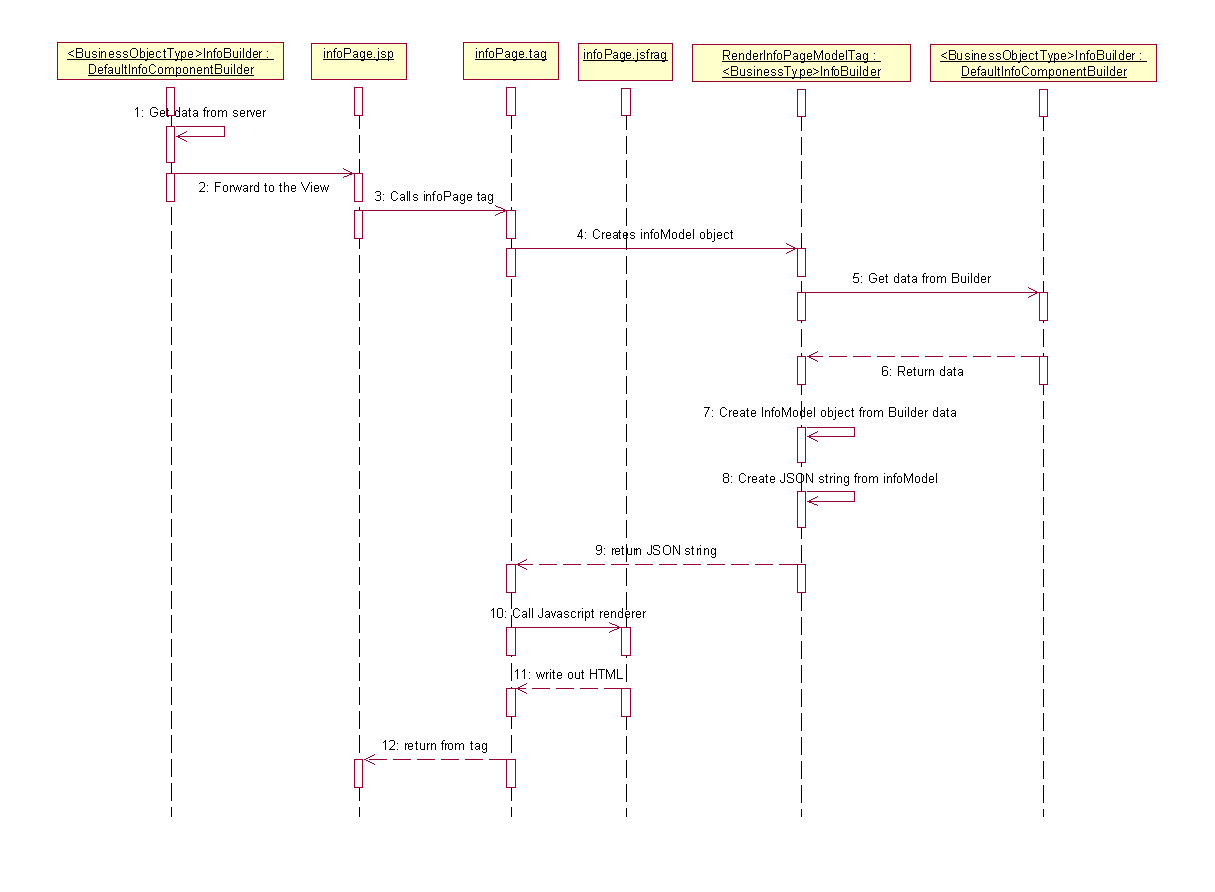Solution
Create a builder Java class, which extends DefaultInfoComponentBuilder, defining the elements rendering on the information page for a specific business object type. The attribute layout manager in the Type and Attribute Management utility controls the layout of the attributes.
Prerequisite Knowledge
To apply this information, you must understand the following:
• The MVC framework for creating the Java builder class (see MVC Components)
• The actions framework in the Windchill client architecture (see Action Framework for Windchill Client Architecture)
• How to manage attribute layouts using the Type and Attribute Management utility (see Type and Attribute Management utility)
Solution Elements
Using this component, a developer must create a builder by extending DefaultInfoComponentBuilder.
|
Element
|
Type
|
Description
|
|---|---|---|
|
DefaultInfoComponentBuilder.java
|
Java class
|
The default builder that all other information page builders must extend from. The builder is responsible for gathering the required data from the server.
|
The below table displays the core elements used to generate the information page. These are not expected to be overridden by a developer. The builder is where a developer can control the items displayed on the information page for a business object and use the Type and Attribute Management utility to manage the layout of attributes.
|
Element
|
Type
|
Description
|
|---|---|---|
|
infoPage.jsp
|
JSP
|
The JSP that all information page actions must invoke. It calls begin.jspf and end.jspf . It also calls the infoPage tag in the MVC taglib.
|
|
infoPage.tag
|
Tag , defined in the MVC taglib
|
Sets up the JSP context and creates the info page ComponentDefinition object. It calls the renderInfoPageModel tag in the components taglib and calls the JavaScript renderer to generate the HTML for the information page.
|
|
RenderInfoPageModelTag.java
|
Java tag, defined in the components taglib
|
It constructs a JSON object (also called as InfoModel) from the data in the builder and writes out the JSON object to its print stream.
|
|
infoPage.jsfrag
|
JavaScript fragment
|
JavaScript renderer that takes in the JSON InfoModel object. It generates the HTML for the information page.
|
|
myTab.jsfrag
|
JavaScript fragment
|
Renders the top-level tabs and provides the ability to move items around in the tab content area.
|
Supporting Elements
|
Element
|
Type
|
Description
|
|---|---|---|
|
attributePanel.jsp
|
JSP
|
JSP to invoke to render an Attributes Panel. The Attribute Panel component is used to display the “Attributes” and “Visualization and Attributes” widgets. The layout of the attributes in an Attribute Panel is controlled by the attribute layout manager in the Type and Attribute Management utility. For more information, see Attribute Panels.
|
|
attributePanel.tag
|
Tag , defined in the MVC taglib
|
Sets up the JSP context and creates the Attribute Panel ComponentDefinition object. It calls the renderAttributePanel tag in the components taglib and calls the JavaScript renderer to generate the HTML for the attribute panel.
|
|
RenderAttributePanelTag.java
|
Java tag, defined in the components taglib
|
It constructs a JSON object (also called as InfoModel) from the data in the builder and writes out the JSON object to its print stream.
|
|
attributePanel.jsfrag
|
JavaScript fragment
|
JavaScript renders that take in the JSON InfoModel object. It generates the HTML for the attribute panel.
|
Information Page Process Flow
Firstly, call the builder to collect the necessary data from the server. The builder then forwards the request to the view (that is,infoPage.jsp). The default view, infoPage.jsp includes the infoPage tag. The tag creates a JSON object, known as the infoModel object, from the data it collected from the builder. The infoModel is serialized (by writing it out as JSON string to the JSP writer) and passed to the JavaScript render generating the HTML.
Here is the process sequence for rendering the info page:

Information Page Builder Designer
When creating an information page for a new business object type, a developer will have to create a builder that extends the DefaultInfoComponentBuilder.The builder class needs to include the following Java annotations, so the correct builder gets called for that business object type:
@ComponentBuilder(value = ComponentId.INFOPAGE_ID)
@TypeBased(value = "wt.part.WTPart")
public class PartInfoBuilder extends DefaultInfoComponentBuilder {
….
@TypeBased(value = "wt.part.WTPart")
public class PartInfoBuilder extends DefaultInfoComponentBuilder {
….
The annotation for the builder ID is specified in the super class DefaultInfoComponentBuilder. Annotations are inherited. Hence, when extending this class, the ComponentBuilder annotation is not required. However, ensure that you include the annotation if you do not extend this class.
For information on registering your builder class or package, see MVC Components.
The only method that must be overridden is the buildInfoConfig() method. In this method, configure the elements you prefer to view on the information page for that business object type and call the required service APIs to gather the data for those elements. For more information about the elements, see Customization Options in Info Page Builder.
The builder's annotation can contain a hard type or a subtype:
@TypeBased(value = "wt.part.WTPart")
@TypeBased(value = " com.company.SoftType")
@TypeBased(value = " com.company.SoftType")
For more information, see TypeBased in MVC Components Overview.

Parent topic